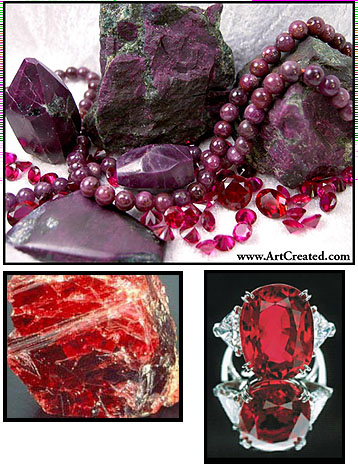Articles by EJA Members
Ah, Ruby!
by Jill of JQJewelryDesigns
The Queen of gems, deep red ruby is the rarest and most valuable gemstone. It's the second hardest natural mineral, next to diamond. Above all other gemstones, including Diamonds, Rubies are the most expensive per Carat - a 15.97 Carat faceted Mogok Ruby was sold at Sotheby's in New York for an amazing $3,630,000 in October 1988. This comes to $227,301 per Carat!
It is from the Latin "ruber" meaning red. Because of its beauty and rarity, the Greeks called it the mother of all gemstones. The Romans called it a flower among stones. Ruby varies in color from dark to purple red, and is the July birthstone. It's the anniversary gemstone for the 15th and 40th year of marriage and the Zodiac Birthstone for Capricorn.
The earliest record for the mining of Rubies goes back more than 2,500 years ago in Sri Lanka. Burma is the world's largest provider of high quality Rubies. Burmese Rubies from the Mogok Valley are considered the finest in the world. Thailand, with large deposits near the Cambodian border, was previously the world's largest provider of Rubies, but the mining has fallen off recently. Bright red stones are mined in Afghanistan, Pakistan and Vietnam. Brownish-red rubies are from Thailand. Darker stones are generally produced from the mines in Australia, India, Russia and USA (Georgia, North Carolina and Wyoming). African Rubies have heavy inclusions and India is famous for supplying Indian Star Rubies. Gems without inclusions are very rare. Most have inclusions which are not visible to the naked eye, and they don't reduce the value of the stone as long as there is brilliance.
This gem can be many shades of red including orangy-red, purplish red or brownish red. Once it becomes too pink it is really pink sapphire. Most Rubies are heat treated to permanently improve their color and appearance. It was one of the earliest gemstones to be synthesized in a laboratory. Manmade Ruby has been around for generations. It is often found in estate and antique jewelry from the very early 1900's through today.
Few other gems have as much myth, lore and romance surrounding them. Many people believe that mystical powers lie within a ruby. The ancient Burmese believed that the stone generates a mystical force when it was inserted beneath the skin. They believed that this force protected the wearer from accidents and attacks. These gems were believed to provide their owners the protection from misfortune and bad health. In the ancient world, many believed that Rubies contained prophetic powers, enabling the wearers to predict their future based on the color changes of their gemstones.
It is known as the stone of love and it was once believed that if worn in a ring on the left hand or in a brooch on the left side, it would give the magical ability to live in peace among enemies. This stone was once thought to ward off bad luck and sickness. Ruby is given as a symbol of success, devotion, integrity, health, and passion.
DID YOU KNOW?
The largest ruby is in the crown of Charles IV, of Luxembourg, King of Bohemia. This birth stone is 250 carats and Charles placed this crown on the skull of Saint Wemaslas, duke of Bohemia, in 1346.
The Carmen Lucia Ruby is the largest faceted ruby in the National Gem Collection and one of the finest Burmese rubies known to exist in the world. Christian Sampler, director of the National Museum of Natural History, says it's the most significant addition to the National Gem Collection since the Hope Diamond came to the museum in 1958. It is a spectacular 23.1 carat Burmese ruby ring, donated to the Smithsonian Institution by billionaire Peter Buck in memory of his wife Carmen Lucia.
